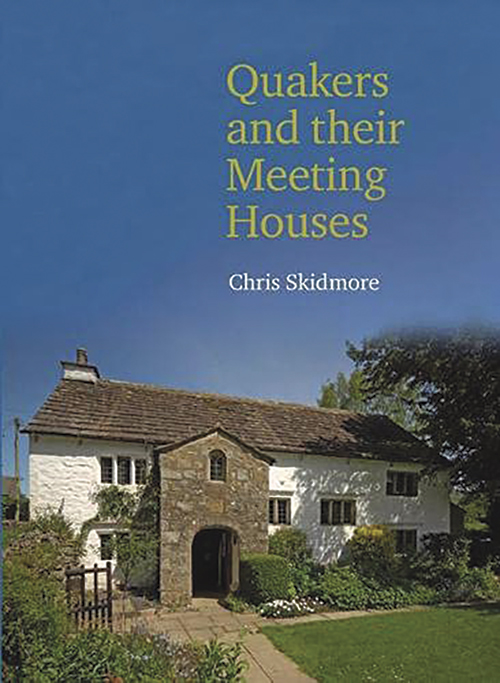
Quakers and Their Meeting Houses
Reviewed by Brian Drayton
August 1, 2022
By Chris Skidmore. Liverpool University Press, 2021. 176 pages. $75/hardcover.
FJ readers can use code ADISTA5 for 30% off at the OUP website for U.S. customers.
Meetinghouses can matter, though worship can happen anyplace as well as anytime, and from the beginning, Friends have gathered in homes, barns, pubs, and fields. The meetinghouse says something about those who built it and worship(ed) there, and when you sit down on a First-day morning, you are accompanied by memories of all who have preceded you. I often recall some words of William P. Taber’s:
Recently I stood in an old, unused meetinghouse within the smell of the salt marshes in southern New Jersey. As I stood in the ministers’ gallery and gripped the handrail . . . my mind was flooded with a sense of the great stream of divine caring which had flowed forth from that gallery across the years.
Chris Skidmore has written an architect’s survey of (mostly) British meetinghouses, which keeps steadily in mind the life of the meetings that gathered in the buildings. Friends have never been quite as “peculiar” a people as we like to think: the “world” has always influenced our clothing, our theology, our politics, and (naturally) our meetinghouses. Skidmore traces meetinghouse designs from the earliest-known down to the present day, comparing the designs to contemporary styles. The earliest houses constructed were very much in the style of contemporary cottages: small and very simple. Yet even in the first decade, the need arose for more capacious buildings with associated structures to accommodate various other purposes. Many had a small dwelling space attached to the worship space: for caretakers, for visiting Friends, or for the needy. Stables also became a valuable facility, especially when the meeting was used for gatherings like quarterly meetings, which might hold for two or more days.
While meetinghouses might resemble other kinds of buildings on the outside, some distinctives of Quaker belief shaped interior design. Most evident was the lack of pulpit, replaced by facing benches, with an elders’ bench and elevated seats for ministers. (U.S. Quakers may be unfamiliar with the British term “ministers’ stand.”) The Quaker testimony that ministers are called and equipped by God has always implied that there may be many tested men and women ministers in a meeting, so one or more benches were needed. Many meetinghouses also had galleries for “overflow,” though in time these upstairs accommodations in some places came to be used for the women’s meeting for business; for rambunctious youth (accompanied by a few serious, brave adults); or for freed slaves not admitted to the main body of the meeting.
As Friends became more prosperous, meetinghouses became more impressive outwardly, and starting in the late eighteenth century, architects were retained more and more often to design new or refurbished structures. As Quakerism changed, so did the meetinghouses. Various contrivances were developed to accommodate the gradual adoption of separate womens’ meetings for business, which continued its spread throughout the 1700s but started to decline in the 1800s, leaving behind the shutters, galleries, or other structures that enabled men and women to meet separately for business but together (in some fashion) for worship. I know of only one meeting that maintains men’s and women’s sections for worship.
Over the course of the late 1800s, London Yearly Meeting gradually phased out the formal recording of ministers, rendering the ministers’ “stand” or “gallery” obsolete as such. Starting around the turn of the twentieth century, the yearly meeting recommended that new structures be built without such distinct areas, and in some cases, renovation removed them. The hollow square (rectangle, circle, and even one oval) has become the characteristic seating arrangement.
Moreover, there are numerous examples of meetinghouses designed to emphasize light, with skylights or “lanterns” or other elements that bathe the worshipers in light from many directions, thus lessening the sense of separation from the outer world.
In addition to describing the changing face of meetinghouses over time, Skidmore notes the building and design of other Quaker structures, such as schools and the administrative centers for London/Britain Yearly Meeting (Devonshire House and then Friends House). He also notes (and shows a plan for) the long-forgotten “booths” that were constructed for the temporary accommodation of the annual gatherings for worship and public testimony that were held in various places around the yearly meeting (such as the yearly meetings at Skidmore and Bristol). These events, at which numerous ministers were present, drew in Friends and non-Friends by the hundreds from the country round (as described in contemporary journals) and also purveyors of food and drink to supply the attenders during the days of the gatherings.
The book is beautifully and carefully produced, full of photographs and drawings, and supplied with a very helpful glossary of the many architectural terms used in the book. The effect on this reader was an urge to go Quaker sightseeing!
Brian Drayton worships with Souhegan Meeting in southern New Hampshire.


